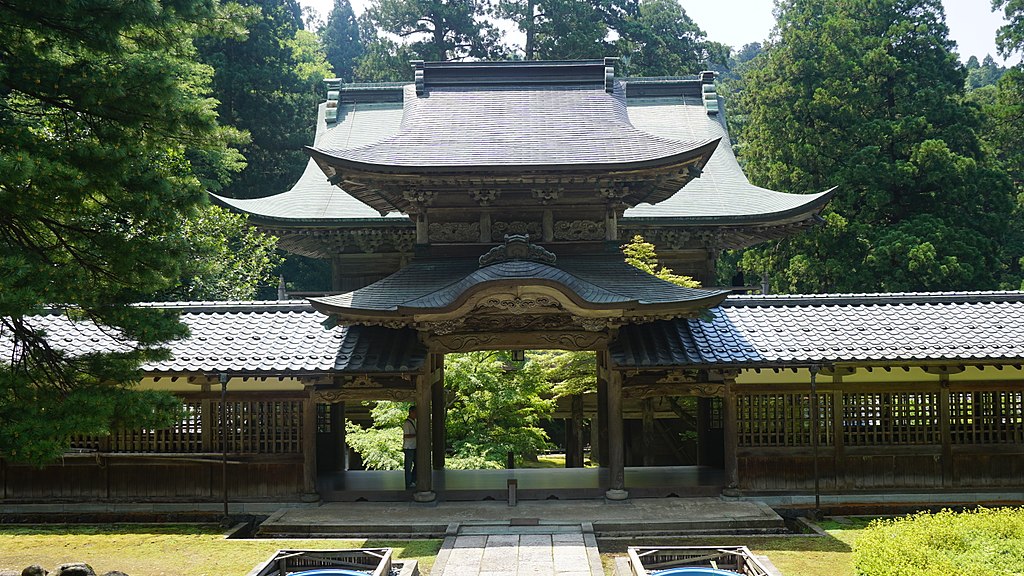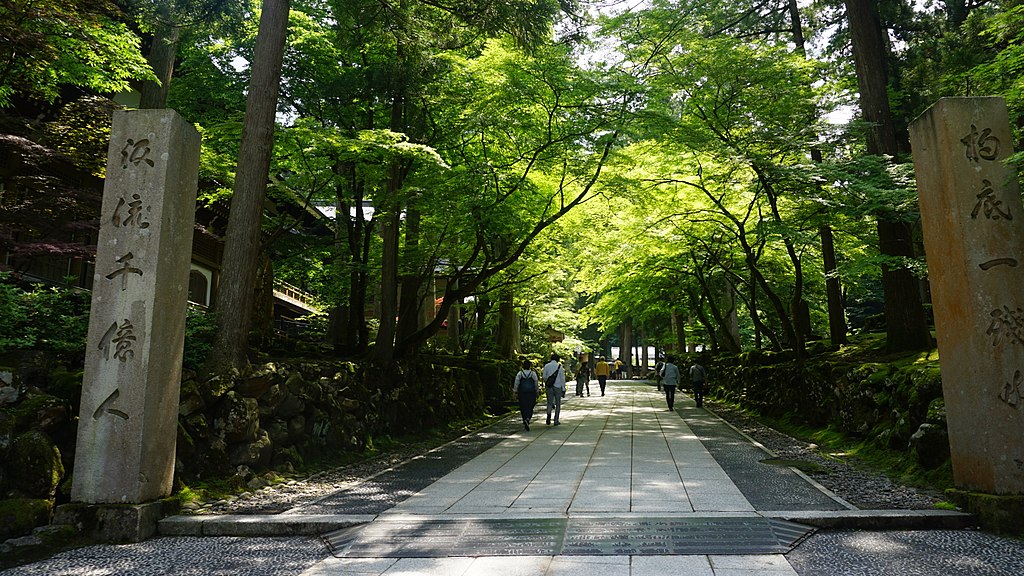
It is in the sixth section of Genjokoan that we find the famous verses that, for many, encapsulate the core of Dogen’s teachings:
“To study the Buddha Way is to study the self.
To study the self is to forget the self.
To forget the self is to be verified by all things.
To be verified by all things is to let the body and mind of the self and the body and mind of others drop off.
There is a trace of realization that cannot be grasped. We endlessly express the ungraspable trace of realization.”
First line: “To study the Buddha Way is to study the self.”
Beware here of the word “study,” which in English brings to mind the idea of an intellectual study of an object by a subject. The Japanese word used is “narau,” which, Okumura says, originated from “nareru” meaning “to get accustomed to,” to become familiar with.” The upper part of the Chinese character for “narau” represents the wings of a bird, and the lower part means “self.” “So narau means to study something in the way a baby bird “studies” flying with its parents. From birth a baby bird possesses the potential to fly, but it must watch its parents to learn how to actually perform the action of flying. The baby watches and tries again and again until finally it can fly like its parents … When we study the self in this way, we cannot see ourselves as the object of our study; we must rather “live out” our selves.” “Narau” was also the word used by the haiku poet Basho in the verse “From the pine tree, learn of the pine tree. And from the bamboo, of the bamboo.” Basho did not mean we should study the pine tree and the bamboo the way a scientist would. He meant for us to enter into the mode of being where the pine tree is the pine tree itself, and the bamboo is the bamboo itself, and from there to look at the pine tree and the bamboo.
The word “self” could also lead to misunderstanding. Buddhist practitioners have repeatedly been told that what we call the “self” has “no own being (“anatman”).” It is not an independently existing agent. In Mahayana the “self” is described as an “activity,” that of the five skandhas in interconnection with the dynamic system of simultaneous interpenetration of all phenomena, as set forth in the Huayan doctrine of Indra’s Net. This is what Okumura is hinting at when he writes: “There is no such thing as a self that is separate from our activity. Dogen Zenji defined this self as jijuyu-zanmai, a term that Sawaki Kodo Roshi described as ‘self selfing the self’.” Okumura also writes: “When a person drives a car, the person thinks “he” as subject drives “the car” as object. But in reality we cannot drive without the car; we can only become a driver or be driven with the aid of the car, and the car can only express its full function as a vehicle of transportation when someone drives it … In a sense the car owns us and shapes us as much as we own and control it, and the action of driving can actually be manifested only by a person and a car working together. The reality of mutual influence and interconnectedness is true not only for a “special” practice done by a group of people called “Buddhists”; in truth this is the way all beings are working within the circle of interdependent origination.”
Second line: “To study the self is to forget the self.”
In the very act of realising the oneness of the self with our activity and all things, we “forget” the self as a separate entity. Okumura writes: “When we study ourselves as the Buddha Way, we find that there is no self that is separate from others because the self is connected with all beings … The self forgets the self in studying the self. This is what we do in our zazen when we open the hand of thought. In zazen, we let go of everything that comes up from the self, including all thoughts, feelings, and emotions … Just sitting is the prajna (wisdom) that sees emptiness without the separation of subject and object. Zazen is not a kind of method of contemplation through which ‘I’ (subject) see ’emptiness’ (object); rather the practice of just sitting is itself prajna.”
Third line: “To forget the Self is to be verified by all things.”
Masao Abe’s translation is “to be confirmed by all dharmas.” Shasta Abbey says “to be experienced by the myriad dharmas.” Kazuaki Tanahashi says “to be actualized by all things.” “To be verified by all things” has the same meaning as ‘all things coming and carrying out practice-enlightenment through the self’. By genuinely just sitting, we root our whole being in the ground of interdependent origination.”
As noted in a previous post, “Practice-enlightenment” is the translation of the Japanese “shusho,” “shu” meaning self-cultivation or practice, in this case the practice of just sitting, and “sho” meaning authenticating, confirming, witnessing or verifying. Dogen holds that zazen, more specifically shikantaza, is “practice-enlightenment,” the sitting practice that trains us to loosen up the thought patterns that keep us entangled in the egocentric standpoint, so that we can live in a world where all things are allowed to be just as they are, empty of being, and mutually interpenetrating.
Okumura then gives a detailed description of shikantaza, which I presented in my post on Fukanzazengi, but may be worth repeating, as this was for Dogen a unique practice, very different from “meditation” as it had been practiced in Buddhism until then, including in the Rinzai Zen tradition, in which Dogen had trained for many years at Kenninji.
“When practicing shikantaza, we do nothing but sit with the whole body and mind. We do nothing with the mind, so this is not actually a meditation practice … We don’t try to concentrate the mind on any particular object … With the eyes open, we simply sit in an upright posture and breathe deeply, quietly, and smoothly through the nose and from the abdomen … Each and every organ in our body continues working in zazen, and there is no reason that our brains should stop working when we sit. Just as the function of a thyroid gland is to secrete hormones, the function of a brain is to secrete thoughts, so thoughts well up in the mind moment by moment. Yet our practice in zazen is to refrain from doing anything with these thoughts; we just let everything come up freely and we let everything go freely. We don’t grasp anything; we don’t try to control anything. We just sit.”
Okumura adds: “Sitting zazen is a very simple practice, but simple does not necessarily mean easy. Yet it is a very deep practice. In zazen we accomplish nothing … But zazen is itself Buddha Dharma, and when we refrain from “doing” in this practice, the self is illuminated and verified by all things. Shikantaza is not a practice carried out by the individual. It is, rather, a practice in which we let go of the individual karmic self … In zazen the true self, the self that is one with the entire universe, is manifest.”
Fourth line: “To be verified by all things is to let the body and mind of the self and the body and mind of others drop off.”
“Dropping off body and mind” is a key expression in Dogen’s writings and an expression frequently used by his teacher Rujing in his conversation with Dogen. Rujing taught that “zazen is dropping off body and mind.” He also described it as removing the five desires (arising from the five sense-organs) and the six coverings (which are roughly the same as the three poisons, greed, hatred and ignorance).
This phrase is associated with the story of Dogen’s “enlightenment” “when Rujing, scolding a monk who was sitting next to Dogen, said, ‘Zazen is dropping off body and mind. Why are you just sleeping?’ The story originally appeared in Dogen’s biography as part of Keizan Jokin Zenji’s Denkoroku (Transmission of Light).” Okumura, however, says that “today some Dogen scholars, such as Sugio Genyu of Yamaguchi University and Ishii Shudo of Komazawa University, think that Keizan invented this story. Otherwise, they say, Dogen’s criticism of practice aimed at attaining kensho becomes a contradiction to his own practice experience.” Dogen always emphasised that shikantaza was a goalless practice, and enlightenment was not to be regarded as an achievement by a personal self, which contrasted to the key role played by kensho in Rinzai practice. Okumura agrees that “it is best to trust Dogen’s own account of his conversations with Rujing concerning dropping off body and mind, rather than give authority to an account apparently invented after Dogen died.”
It remains that, “in his conversations with Dogen, Rujing said, ‘Zazen is dropping off body and mind’ and ‘dropping off body and mind is zazen’. In other words, dropping off body and mind is not some special psychological condition resulting from zazen practice; rather, zazen is itself dropping off body and mind.”
“Dropping off body and mind” is the translation of “shinjin-datsuraku.” “Shinjin” means “body and mind.” The literal meaning of the Chinese character “datsu” is “to take off” or “slough off,” and “raku” means “to drop off,” “cast off,” or “fall down.”
Okumura compares our “karmic self” to a kind of clothing that indicates our social class, occupation, possibly cultural and religious background. We also develop “self-images” as capable or incapable, rich or poor, etc. When we sit facing the wall and let go of thoughts … we “let go” of both clothing and self-images. “In zazen … we become the naked self.” This “letting go” is what “datsuraku” refers to. “In zazen we are not pulled around by the objects of our thinking or emotions, so we are released from the three poisonous minds that bind us to samsara. This just sitting in zazen is itself the practice of nirvana.”
When zazen releases our karmic self from the three poisons, we shed our sense of separateness. “The separation between self and others falls away, is dropped off. Zazen reveals the total reality of interdependent origination. When we let go of thought, we settle our whole being into interpenetrating reality. This is how we are verified by all beings.”
Fifth line: “There is a trace of realization that cannot be grasped. We endlessly express this ungraspable trace of realization.”
On the page entitled “Realization beyond realization,” it was said that “when buddhas are truly buddhas they don’t need to perceive they are buddhas; however, they are enlightened buddhas and they continue actualizing buddha.” It is a fact, Dogen says, that buddhas cannot directly “see” that they are buddhas. “When we are actually practicing and living as a part of interpenetrating reality, we cannot see that we are really living out absolute reality … we cannot ‘see’ this absolute reality as an object of our discriminating minds … We cannot be an observer of absolute reality because we ourselves are part of the total movement of that reality … The world and individuals are working together as one total reality, so we cannot see ‘self’ as subject and ‘the world’ as object.”
Still, even though we cannot directly observe our self as one with the interpenetration of all things, we will express it moment by moment in the way we live. “In zazen and in all the activities of our daily lives, our practice is to try to express this traceless trace of realization and the reality of interdependent origination. This is the point of Dogen Zenji’s teaching in Genjokoan.”
Source:
Shohaku Okumura – Realizing Genjokoan

